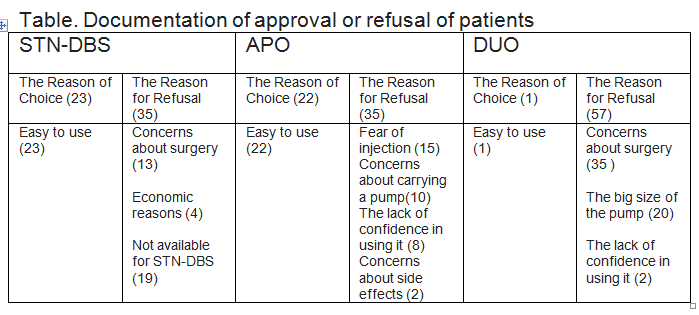Session Information
Date: Saturday, October 6, 2018
Session Title: Surgical Therapy: Parkinson's Disease
Session Time: 1:45pm-3:15pm
Location: Hall 3FG
Objective: Deep brain stimulation of subtalamic nucleus (STN-DBS), subcutaneous apomorphine infusion (APO) and levodopa-carbidopa intestinal gel infusion (DUO) is routinely used in patients with advanced levodopa–responsive Parkinson’s disease (PD) to treat severe motor fluctuations and dyskinesia, which could no longer be managed with available combinations of oral medications.
Background: In this study, we aimed to define the reasons why patients choose one of three device-based treatments.
Methods: We determined Hoehn & Yahr Stages (H&Y), Unified Parkinson’s Disease Rating Scale-2 (UPDRS 2) scores and Social and Occupational Functioning Assessment Scale (SOFAS) scores of patients with PD who were supposed to be suitable candidates to device-based treatments due to their motor problems going on to be disabling despite best medical treatment. All methods of treatment were described to the patients in an appropriate way. Preferences and the reasons for choosing or not choosing were questioned and answers were recorded.
Results: A total of 58 (26 Women / 32 Men) participants were included in this study. The characteristics of the participants were: mean age of onset was 63,05 years, mean duration of disease 10,40 years, and mean duration of motor complications 3,32 years, mean score of H&Y 2,36, UPDRS2 18,05, SOFAS 65,51. After a thorough explanation of all three device-based treatment methods supported by pictures and videos and on hand demonstrations of the electrodes, pumps, and catheters, they were asked about their treatment choice. For 19 patients STN-DBS was inappropriate for neurological reasons like dementia. 22 patients preferred STN-DBS, 22 patients preferred APO, and only one patient preferred DUO. Thirteen patients preferred to go on with medical treatment, whereas one patient positively approached both STN-DBS and APO. The reasons for selecting or not selecting were detailed in the Table.
Conclusions: In this series most of patients choose the treatment option that was the easiest for them. On the contrary to our expectations only four patients declared a reason of refusal due to economic reasons.
To cite this abstract in AMA style:
M. Kuzu Kumcu, S. Tezcan Aydemir, Ç. Ulukan, B. Bakırarar, C. Akbostancı. Patient’s Choice of Device-Based Treatments in Parkinson’s Disease [abstract]. Mov Disord. 2018; 33 (suppl 2). https://www.mdsabstracts.org/abstract/patients-choice-of-device-based-treatments-in-parkinsons-disease/. Accessed October 14, 2025.« Back to 2018 International Congress
MDS Abstracts - https://www.mdsabstracts.org/abstract/patients-choice-of-device-based-treatments-in-parkinsons-disease/

